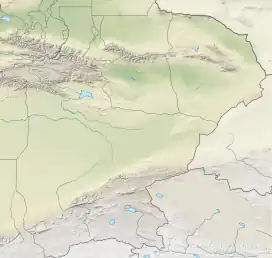| Daxihaizi Reservoir | |
|---|---|
| Da Xihaizi Reservoir | |
| 大西海子水库 | |
 Sentinel-2 image (2022) | |
 Daxihaizi Reservoir | |
| Location | at the end of the Tarim River[1] |
| Coordinates | 40°34′18″N 87°31′13″E / 40.57167°N 87.52028°E |
| Type | reservoir |
| Basin countries | China |
| Built | 1972[2] |
Daxihaizi Reservoir (Chinese: 大西海子水库), also spelled Daxi Haizi Reservoir[3] or Great West Sea Reservoir,[4] is a reservoir at the very end of the Tarim River,[5] 720 km from Urumqi. To the west of the reservoir is the Taklamakan Desert.[6] The reservoir has a storage area of 68 square kilometers, a depth of 2-3 meters, and a total storage capacity of 168 million cubic meters.[7]
History
In 1958, the soldiers of the Second Division of the Xinjiang Production and Construction Corps began to build the Daxihaizi Reservoir.[8] In 1972, after the completion of the reservoir in the middle reaches of the Tarim River, the 320-kilometer section of the lower Tarim River dried up. In 1974, Taitema Lake completely dried up.[9]
In 1993, the Daxihaizi Reservoir dried up completely for the first time in its history.[10]
In 2012, the reservoir was withdrawn from the agricultural irrigation system,[11] and became a purely ecological reservoir.[12] In May 2014, the Daxihaizi Reservoir was officially transferred from the XPCC to the Tarim River Basin Bureau (塔里木河流域管理局).[13]
References
- ↑ "A lonely and persistent river flows between two deserts". Xinhuanet.com. 2019-09-10.
- ↑ "Tarim River receives third water replenishment". Radio Free Asia. 2001-04-27.
- ↑ "Research on the Early Warning Model of Environmental Desertification Based on Grid Scale" (PDF). Nature Environment and Pollution Technology. Jul 28, 2019.
- ↑ Ståhlberg, Sabira; Svanberg, Ingvar (November 15, 2010). "Loplyk Fishermen: Ecological Adaptation in the Taklamakan Desert". Anthropos. 105 (2): 423–439. doi:10.5771/0257-9774-2010-2-423. JSTOR 25734813.
- ↑ Č Maksimović; David Butler; Fayyaz Ali Memon (2003). Advances in Water Supply Management: Proceedings of the International Conference on Computing and Control for the Water Industry, 15-17 September 2003, London, UK. Taylor & Francis. pp. 707–. ISBN 978-90-5809-609-8.
- ↑ Journal of Geography. Chinese Geographical Society. 2007.
- ↑ "Witness the green changes of today and tomorrow". Sina. Aug 11, 2017.
- ↑ "Daxihaizi Reservoir was officially transferred to Tarim River Basin Bureau". Xinhua News Agency. 2014-05-29.
- ↑ "Water to Flow Again in Dry Section of China's Longest Inland River". People's Daily. April 27, 2001.
- ↑ Liu Chan (2018). A Study on the Construction of a Natural Resource Property Rights System in China. Sonbook Publishing Co., Ltd. pp. 296–. GGKEY:LBUETBXRD3Q.
- ↑ "7 billion cubic meters of ecological water transported to revitalize the Tar River basin". Sina. 2018-08-10.
- ↑ "Largest lake in history formed downstream of Tarim River". Wenhui Bao. Nov 12, 2017.
- ↑ "The Second Division of the Corps and the local hand in hand to build the Tower River green ecological home". Sina. Jun 19, 2014.